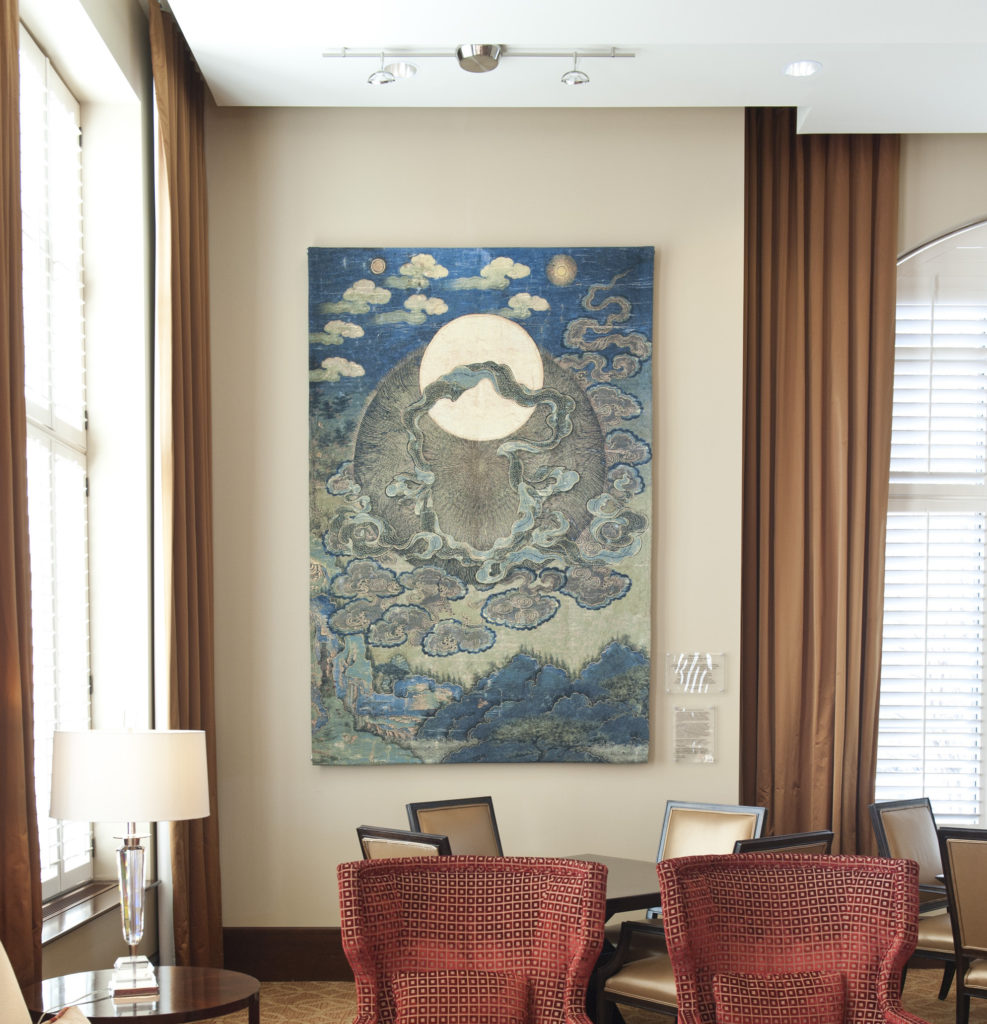Whether repositioning an older community or building fresh from the ground up, decorating can make or break a senior living project. Sure, some senior living facilities boast world-class art—but not every community is going to have this opportunity. Every provider can, however, use artwork to increase resident satisfaction and drive interest in its communities. Senior Housing News talked to two prominent providers based in the Chicago area for some tips on how to do just that.
1. Choose hyper-local art.
In each of its communities, Mather LifeWays makes a concerted effort to curate pieces that are inspired by or reflective of the local area, company CEO Mary Leary tells Senior Housing News. This includes art created by local artists, such as the “Land Buoy” sculpture displayed outdoors at Splendido at Rancho Vistoso, Mather’s life plan community (formerly continuing care retirement community, or CCRC) in Tucson, Arizona.
The Tucson community also has handwoven Navajo baskets and Kachina Dolls made by Hopi Native Americans on display.

Meanwhile, several paintings at The Mather, the company’s life plan community in Evanston, Illinois, “tell a great story” about what life was like in that exact community 60 or more years ago, Leary says. Back in those days, residents at The Mather used to paint over existing canvas paintings to help conserve costs and supplies.
Two paintings dating back to 1840 were covered up by residents who had painted over them, The Mather discovered. The residents’ paintings were replicated, and then The Mather had the original paintings restored. The canvases—which now show portraits of Alonzo Mather’s family members who lived in the 1600s and 1700s—currently hang in the community.
The Mather is not the only senior living community in Chicagoland that has embraced a hyper-local approach to decorating.
“Our big focus with art is making it look and feel like Chicago,” Kyle Exline, executive director at Chicago CCRC The Clare, tells SHN. This is accomplished by either choosing artwork by a local Chicago artist, or artwork that is inspired by the Windy City.

Art, as a whole, has been “incredibly important” to the 53-story building’s multi-million dollar renovation, Exline says, calling it one of the renovation’s “main focuses.”
The Clare specifically commissioned pieces the works of art in lobby, and one of its marketing offices is decorated with photographs of the most famous staircases in Chicago. The community has also been able to incorporate old architectural pieces into its decor, including pieces of old buildings.
The Clare’s residents are familiar with Chicago, so it makes sense to decorate this way—95% have lived in Chicago at one time or another, and 75% move directly from the city to The Clare, Exline estimates.
2. Showcase residents’ art—both created and donated.
Mather LifeWays embraces the opportunity to showcase residents’ artwork, be it created by the residents themselves or donated from their personal collections.
The residents who live in Mather communities value art, and in many cases have been art collectors throughout their lives, Leary says. That’s wound up benefiting Mather LifeWays communities in the long run.
“Our residents have been very generous in donating art, or loaning art for everyone to see, as opposed to keeping it in their apartment,” Leary explains.
The Mather is currently displaying “a beautiful, handmade tapestry” given to a resident by the Dalai Lama, who recognized her for her work at the United Nations’ Special Sessions on Disarmament and as co-chair of Americans for the SALT Treaty, Leary says.

A different couple at The Mather donated a sculpture by Richard Hunt, a sculptor from Chicago, that is currently located in the community’s garden.
At The Mather, there’s “a gateway gallery” that connects two buildings 30 feet below the water table of Lake Michigan. The gallery displays resident art, as well as historical art and artifacts, including stained glass windows. The Clare has something similar: an art gallery that showcases pieces created by residents for weeks or months at a time.

Mather Place of Wilmette, an independent living community in the northern Chicago suburb of Wilmette, has a water droplet photograph by 102-year-old Splendido resident Irving Olson on display. It took Olson, who has been taking pictures for 90 years, three years to perfect his technique of photographing the droplets.
Mather LifeWays has also been known to display the work of residents’ family members. A glass “bubble” wall, which residents pass as they enter The Mather’s spa area, was hand-forged by a resident’s daughter, Leary says.

3. Make sure that the art carries through the entire community, especially to the care settings.
Indoors, Mather LifeWays incorporates art into nearly everything—there’s art in the furnishings, fixtures, window treatments and floors, Leary says. At The Mather in Evanston, there are Thai silk window treatments and a “Chinese cloud” patterned carpet, for instance.
That same attention to artistic detail can be found outdoors, as well.
Several sculptures that have been gifted to Mather LifeWays communities are now on display in outdoor spaces, Leary says. This is especially true at Splendido, where 1% of the construction budget had to be allocated to public art that the community at large could come and see.
“More and more municipalities are requiring public art to be displayed in new developments, and Splendido had a public art requirement when we developed the community,” Leary explains. In response, the company chose to emphasize art that could be seen from the outside of its Tucson community—including the “Land Buoy” sculpture.
The Clare’s location one block off of Chicago’s Michigan Avenue “was a constant conversation” during the community’s renovation, Exline says, which led to the community’s finishes, fixtures—“everything”—being taken into careful consideration.
That’s something all providers can do to make their community complete.
Written by Mary Kate Nelson


